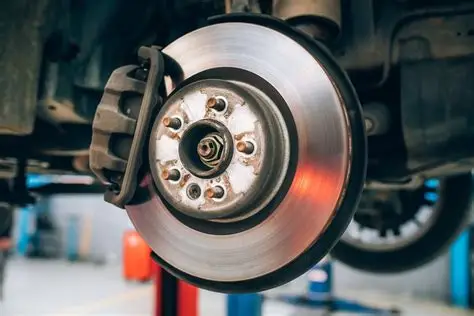
RWS Thirsk Garage Brakes and pads
Booking & Enquiries
Do I need my brakes looking at?
If you have concerns over your brakes the best idea will be to come get them checked over, usually there are tell tale signs
Grinding – the most common concern over brakes, this will indicate the brakes are worn and there isn’t enough material on the brake pads. The term ‘metal to metal’ is used, these should be looked at straight away because its likely to damage the disc.
Squeaking – Many reasons why your brakes are squealing but the most common is: that your calliper has seized and the brake pad remains touching the brake disc. Best way to know will be to get them checked out as another problem could occur.
Pulsating -A continuous pulsating from the brake pedal could indicate the brake disc is warped. This is due to excessive heat and causes the brake disc to be distorted, meaning there isn’t a flat surface for the brake pad to make contact. If it isn’t a warped disc it could be the ABS, either way it’s best to get them checked out.
Pulling – A vehicle pulling left or right could indicate a seized calliper. A full inspection will be required as this could lead to more implications.
Sponginess – if the brake pedal is spongy and seems unresponsive there could be some air within the brake lines, therefore preventing the brake fluid from flowing through this system effectively.
Soft brake pedal – if the brake pedal is limp and goes all the way to the floor get it checked immediately as this could indicate a serious fault. There are various problems this could mean including, the brake fluid is ineffective and needs replacing or even more serious something wrong with the master cylinder.
Dashboard Light – if the brake warning light is lit or keeps coming on when the Brake is applied it could indicate the brake fluid is critically low or there is a leak in the brake hoses.
High handbrake – a high handbrake could mean the it needs adjusting, usually anything more than 6-8 clicks. This is an MOT failure and needs replacing or adjusting.
Old brake Fluid – old fluid won’t be as effective as new brake fluid because of its hygroscopic properties meaning it absorbs fluid over time. This will have a negative affect on the braking ability. Brake fluid should be changed every two years to ensure effective braking systems, check with your manufactures handbook for more information.
When should I replace my brakes?
If you are a motorway driver your brakes could last up to 60,000 miles whereas a city driver many only last 25,000 as more frequent braking then been on a motorway.
Front brakes normally wear out before rear brakes because of the higher percentage of braking loads, even more so on front wheel drive vehicles.
The rule of thumb is if the braking pad thickness is below 3 millimetres they should be replaced.
Brake disc thickness should be measured and referee back to the manufactures safe minimum thickness.
Replacing brakes should be done in pairs to ensure equal performance.
Once new brakes are fitted it’s important to drive careful and gentle until you’ve been the brakes in, this process is approximately 200 miles.
How do brakes work?
The force applied to the pedal is multiplied through leverage which then, in turn, initiates a hydraulic system. Hydraulic systems run on incompressible fluids, in this instance brake fluids. The leverages force at one end, pushes a piston into a brake cable, which pushes the fluid through the brake cable and pushes a piston out the other end, apply the friction to a wheel. This is the braking system. This friction is relayed through the tyres to the ground and vehicle comes to a stop.
Different braking systems
Drum brakes – Drum brake systems are commonly used on the rear of a vehicle, the hydraulic system is initiated by pressing the brake pedal which causes two shoes inside a drum to move outwards making contact with the inner surface of the drum, causing resisting friction. The drum is connected to the wheel, so in this instance, results in friction being simulated from the drum to the wheel and causes the vehicle to stop.
Disc brakes – Disc brakes may be on the front wheels or, more frequently, on all four wheels. The hydraulic system is initiated by pressing the brake pedal which causes two pistons to push two pads onto either side of a disc in a clamping motion. Brake discs are fixed to the wheels, therefore, when the pads clamp onto the disc, friction occurs and the wheels slow down bringing the vehicle to a stop.
ABS ( Anti-Locking Brake System) – ABS works on the principle that locked or skidding wheels will not create enough friction to stop the vehicle safely. So, ABS is ther to assist the driver when elements out of their control prevent a safe stop, there are four main components to the ABS system: speed, sensor, controller valves and pumps.
Speed sensors appear on each wheel while relay speed measurements to the controller, which is an on board intelligence computer chip. Depending on the measurements the controller will operate valves in the brake fluid line to either remain:
Open – Allowing normal operation
Closed – Stopping excessive pressure through the fluid to the braking system to prevent brake lock.
On narrow – to minimise the pressure through the brake lines again to prevent brake lock.
In instances where valves close or narrow, a pump is in place to restore normal fluid pressure back to the lines after the vehicle has stopped safely.
Do I need my brakes looking at?
If you have concerns over your brakes the best idea will be to come get them checked over, usually there are tell tale signs
Grinding – the most common concern over brakes, this will indicate the brakes are worn and there isn’t enough material on the brake pads. The term ‘metal to metal’ is used, these should be looked at straight away because its likely to damage the disc.
Squeaking – Many reasons why your brakes are squealing but the most common is: that your calliper has seized and the brake pad remains touching the brake disc. Best way to know will be to get them checked out as another problem could occur.
Pulsating -A continuous pulsating from the brake pedal could indicate the brake disc is warped. This is due to excessive heat and causes the brake disc to be distorted, meaning there isn’t a flat surface for the brake pad to make contact. If it isn’t a warped disc it could be the ABS, either way it’s best to get them checked out.
Pulling – A vehicle pulling left or right could indicate a seized calliper. A full inspection will be required as this could lead to more implications.
Sponginess – if the brake pedal is spongy and seems unresponsive there could be some air within the brake lines, therefore preventing the brake fluid from flowing through this system effectively.
Soft brake pedal – if the brake pedal is limp and goes all the way to the floor get it checked immediately as this could indicate a serious fault. There are various problems this could mean including, the brake fluid is ineffective and needs replacing or even more serious something wrong with the master cylinder.
Dashboard Light – if the brake warning light is lit or keeps coming on when the Brake is applied it could indicate the brake fluid is critically low or there is a leak in the brake hoses.
High handbrake – a high handbrake could mean the it needs adjusting, usually anything more than 6-8 clicks. This is an MOT failure and needs replacing or adjusting.
Old brake Fluid – old fluid won’t be as effective as new brake fluid because of its hygroscopic properties meaning it absorbs fluid over time. This will have a negative affect on the braking ability. Brake fluid should be changed every two years to ensure effective braking systems, check with your manufactures handbook for more information.
When should I replace my brakes?
If you are a motorway driver your brakes could last up to 60,000 miles whereas a city driver many only last 25,000 as more frequent braking then been on a motorway.
Front brakes normally wear out before rear brakes because of the higher percentage of braking loads, even more so on front wheel drive vehicles.
The rule of thumb is if the braking pad thickness is below 3 millimetres they should be replaced.
Brake disc thickness should be measured and referee back to the manufactures safe minimum thickness.
Replacing brakes should be done in pairs to ensure equal performance.
Once new brakes are fitted it’s important to drive careful and gentle until you’ve been the brakes in, this process is approximately 200 miles.
How do brakes work?
The force applied to the pedal is multiplied through leverage which then, in turn, initiates a hydraulic system. Hydraulic systems run on incompressible fluids, in this instance brake fluids. The leverages force at one end, pushes a piston into a brake cable, which pushes the fluid through the brake cable and pushes a piston out the other end, apply the friction to a wheel. This is the braking system. This friction is relayed through the tyres to the ground and vehicle comes to a stop.
Different braking systems
Drum brakes – Drum brake systems are commonly used on the rear of a vehicle, the hydraulic system is initiated by pressing the brake pedal which causes two shoes inside a drum to move outwards making contact with the inner surface of the drum, causing resisting friction. The drum is connected to the wheel, so in this instance, results in friction being simulated from the drum to the wheel and causes the vehicle to stop.
Disc brakes – Disc brakes may be on the front wheels or, more frequently, on all four wheels. The hydraulic system is initiated by pressing the brake pedal which causes two pistons to push two pads onto either side of a disc in a clamping motion. Brake discs are fixed to the wheels, therefore, when the pads clamp onto the disc, friction occurs and the wheels slow down bringing the vehicle to a stop.
ABS ( Anti-Locking Brake System) – ABS works on the principle that locked or skidding wheels will not create enough friction to stop the vehicle safely. So, ABS is ther to assist the driver when elements out of their control prevent a safe stop, there are four main components to the ABS system: speed, sensor, controller valves and pumps.
Speed sensors appear on each wheel while relay speed measurements to the controller, which is an on board intelligence computer chip. Depending on the measurements the controller will operate valves in the brake fluid line to either remain:
Open – Allowing normal operation
Closed – Stopping excessive pressure through the fluid to the braking system to prevent brake lock.
On narrow – to minimise the pressure through the brake lines again to prevent brake lock.
In instances where valves close or narrow, a pump is in place to restore normal fluid pressure back to the lines after the vehicle has stopped safely.

